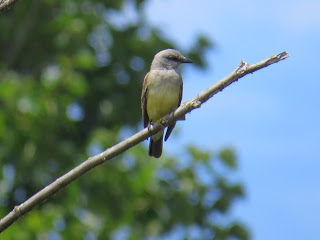On a recent Friday in July, smothered by the blazing midday sun, I strolled the "Union Bay Nature Preserve." This marvelous urban birding oasis was previously known as the "Montlake Landfill," and before that, the "Union Bay Dump." A tip of the hat to Madison Avenue for a great rebranding!
In any case, as the old saying goes, "one man's trash is another man's treasure," and this landfill delivers a wealth of aerial acrobats. Beneath my feet were decades of detritus, civilization's castings, and, one imagines, the hand-scribbled letters of ardent yearning between long-forgotten lovers. Above me were swallows, eagles, egrets, and many other kinds of beautiful wetland inhabitants.
One interesting character caught my eye high on a branch above a small pond in the preserve:
A fellow birdwatcher stood nearby bearing a camera so large it might make Edwin Hubble blush. Neither he nor I could identify this bird in the heat of the moment. I rattled off a series of almost-random guesses as to the species, yet my compatriot merely nodded unconvinced. He grinned that polite but dubious grin of the incorrigible skeptic.
Upon returning home I did a little research and identified this bird as a Western Kingbird. Kingbird's get their name from their dominant, aggressive behavior. They will attack larger birds, like hawks, and even humans if they feel threatened. The individual I encountered was resting lazily on a branch, presumably keeping an eye out for a swarm of flies to attack.
According to my field guide this bird is a "scarce migrant to Pacific Northwest." I hope this particularly adventurous member of his species enjoyed his foray to the edge of his species's range!










